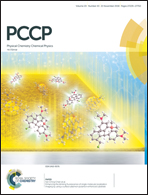Photoinduced energy transfer in carbazole–BODIPY dyads†
Abstract
A series of carbazole (CBZ)–boron dipyrromethene (BODIPY) based donor–acceptor dyads, CB1, CB2, and CB3, with CBZ as an energy donor, tethered together with spacers of varied sizes i.e., phenyl bridge, biphenyl bridge and diphenylethyne bridge, respectively, are reported. The newly synthesized dyads were characterized by various spectroscopic techniques. A comparison of the absorption and electrochemical data of the dyads with their reference compounds (i.e., 9-phenyl-9H-carbazole (C0) and N,N′-difluoroboryl-1,3,7,9-tetramethyl-5-phenyldipyrrin (B0)) revealed minimal ground-state interactions between the chromophores. Selective excitation of CBZ in the dyads at 290 nm resulted in the quenching of the CBZ emission followed by the appearance of BODIPY emission, revealing efficient energy transfer from singlet excited CBZ (1CBZ*) to BODIPY. The photoinduced energy transfer phenomenon was studied in three different solvents of varying polarity. The driving forces for energy transfer (ΔGEN) for all the dyads were found to be exothermic. The rate constants for energy transfer, kENT, measured by the femtosecond transient absorption technique in toluene were found to be in the range of 0.8–2.0 × 1010 s−1, depending on the type of spacer between the CBZ and BODIPY entities, and were in close agreement with the theoretically estimated rates according to the Förster energy transfer model. In contrast, selective excitation of BODIPY in these dyads at 485 nm resulted in small quenching of the BODIPY emission, suggesting a lack of major photochemical events originating from 1BODIPY*.



 Please wait while we load your content...
Please wait while we load your content...